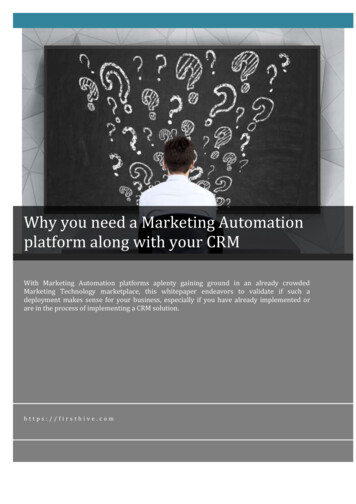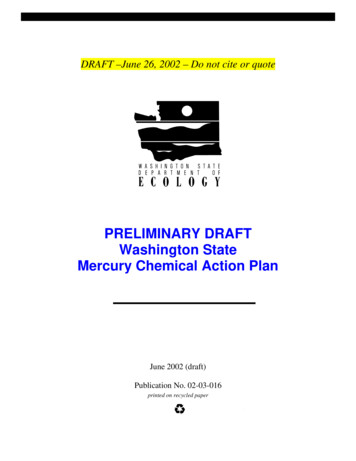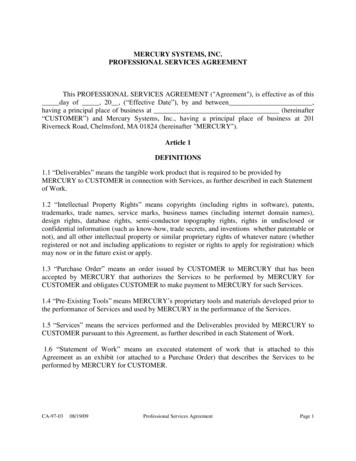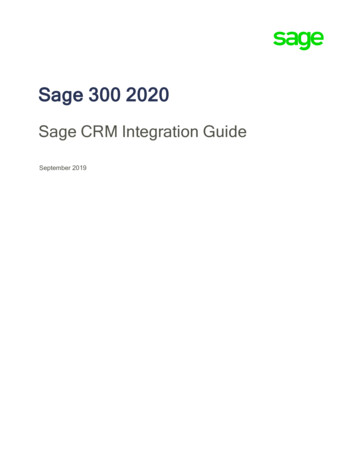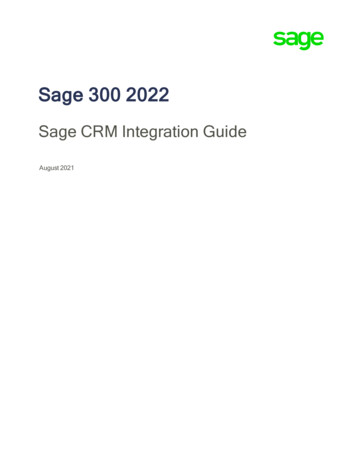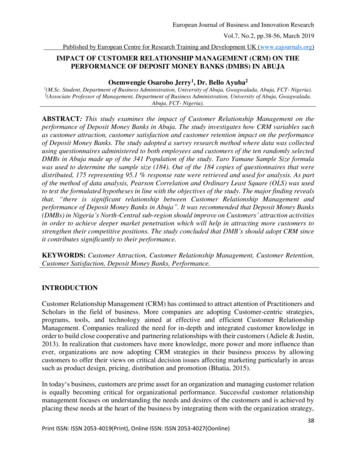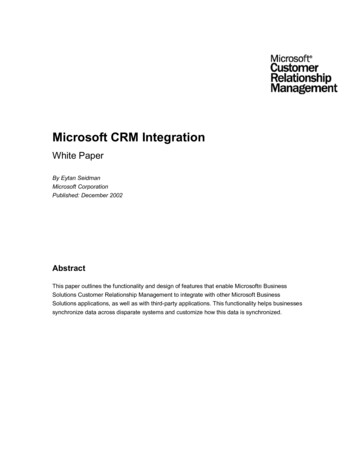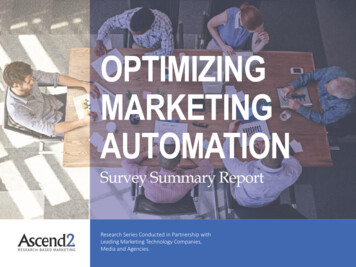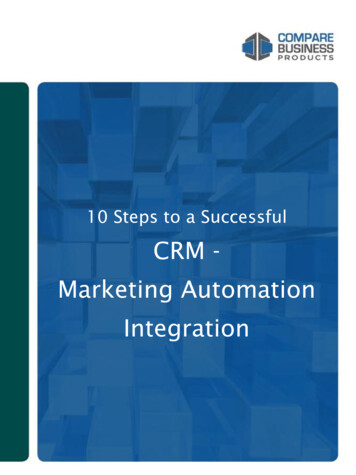
Transcription
Subtitle10 Steps to a SuccessfulCRM Marketing AutomationIntegrationCRM - Marketing Automation Integration Compare Business Products 20141
ContentsIntroduction . 31.Build Communication Before You Start. 32.Set Goals . 43.One-Click Access and Other User Friendly Features . 54.Start with Cleansed Data . 55.Implement Data Population Shortcuts . 66.Auto-Sync Data to Reduce Errors . 67.Avoid Lead Leaks . 78.Use an API . 89.Provide Training. 810.Choose One Reporting Option . 9References . 10CRM - Marketing Automation Integration Compare Business Products 20142
IntroductionMore and more commonly businesses are working to integrate their CRM systems with amarketing automation platform. Marketing automation is considered to be one of the mostimportant areas of CRM growth. In 2012 Gartner reported that this would continue to bethe case with marketing automation achieving 10.7% annual growth rates right through2016. This means that the current interest inand trend towards marketing automation is setMarketing automationto continue.will achieve 10.7%CRM and marketing automation platforms areannual growth ratedifferent but have complementary features,since both involve the use of customer data forthrough 2016.different business purposes. Linking CRM andGartner 2012marketing automation systems together makessense, since if it is done well, it can reduceduplication of effort in the sales, marketing and customer services teams. It allows themarketing automation system to benefit from the data that is already collected in the CRMsystem and increase marketing effectiveness.Through careful planning, an integration of the two systems can save both time and moneyfor organizations. Done badly however, a CRM and marketing automation systemintegration can create duplication of data that leads to inefficiencies throughout theorganization. So what can be done to make sure that the marriage between the CRMsystem and the marketing automation platform is a happy one? The answer lies in workingeffectively with both systems and people to drive results.1. Build Communication Before You StartMarketing and sales need to agree on common definitions and ways of working for thisintegration to be successful. This is sometimes easier said than done. However, it mustbe addressed, since not dealing with it can lead to resistance to using the newly integratedtools.CRM - Marketing Automation Integration Compare Business Products 20143
Resistance is one of the most common reasons that change in organization fails, andaccording to McKinsey 70% of change efforts end in failure. Getting people from all teamsinvolved right at the start of the project and ensuring these employees will champion thenew processes in their respective sales, marketing and customer service teams can helpto overcome this particular challenge. Overall it is very important that everyone is workingin the same way and is on the same page regarding expectations. Fostering relationshipsbetween the departments will help.70% of changeRelated to this point but on a side note, it is critical thatyou never expect systems to fix problems due to poorefforts end uprelationships. If relationships between the sales,in failure.marketing or customer service teams are broken beforeMcKinseyyou try to implement the system, putting the system inplace will not resolve these problems. Again, this is likelyto lead to resistance to using the system, or working with the other departments to makeit work. Building these relationships before implementing the system is essential to thesuccess of the integration.2. Set GoalsBefore starting any system implementation or integration, understanding the goals isimportant. If you do not define goals and do not measure return on investment, you willnot know how successful or otherwise you have been and you will fail to effectivelyevaluate what you have achieved and how you might improve the situation.For example, according to Salesforce (2013) 68% of companies have not identified orattempted to measure their sales funnel. It may be at least part in due to this that anamazing 79% of marketing leads are never converted into Sales (Salesforce, 2013).Having marketing automation and CRM systems working together can have significantbenefits and can address common challenges that sales and marketing teams have todeal with, such as poor lead quality, improving the ways that both departments worktogether and making marketing more accountable, but this can only really successfully beachieved if there are set goals that everyone is working towards. Defining and measuringthe sales funnel is a part of this, and so is both marketing and sales accountability. SettingCRM - Marketing Automation Integration Compare Business Products 20144
goals will help understand what has been accomplished and what still needs to beimproved after the integration has occurred.3. One-Click Access and Other UserFriendly FeaturesSystems that do not work well for the users will fail to be a shining organizational successstory.One of the simplest ways to make sure that the integrated systems are user friendly is toprovide one login that works for both systems. Making users have to login to both systemsseparately may not seem like a big deal, but is tedious and painful for users. Being ableto access the information needed from one interface makes working much simpler foremployees. One click access will also increase the chances that users actually use bothsystems.It may seem unlikely that users simply would not use the system, but Dorsey (2005)reports that the failure rate of large systems projects is somewhere between 50% to 80%.One of the reasons for this is a failure to take into account user needs and user friendlinessof the systems when planning the implementation or integration. Automating activities tosave employees time will help users appreciate the system and its benefits more. In turnthey will be more likely to use the system properly, which will mean that the integration willbe more likely to be a success.4. Start with Cleansed DataBefore even starting the undertaking of integrating the marketing automation platform andCRM system, it is critical to have clean data in place. If not, when you synchronize the twosystems, you’ll simply be spreading poor quality data around two systems instead of justone, increasing the margin for error across the organization.CRM - Marketing Automation Integration Compare Business Products 20145
One example is reviewing customer details to make sure that you have the right contactinformation for each customer. As Holler (2011) explains, not doing this can lead tocustomer frustration. For example, if there are two different email addresses registered forone customer in the CRM system, and if these email addresses end up in two differentnurture tracks in the marketing automation system, the customer will get two sets of emailsrather than one (Holler, 2011). No one likes to get spammed, and over communicationwith potential leads is more likely to turn them off than encourage them to buy from yourorganization. Getting this right at the start will help to avoid this kind of error.5. Implement Data Population ShortcutsClosely linked to user friendliness is the implementation of data population shortcuts. Bythis, data entered into one part of the system should also be entered into the otheraccording to McFarlane (2011). Put simply, the CRM system needs to be able to talk withthe marketing automation platform and the marketing automation system should equallybe able to talk to the CRM system.Here’s an example provided by McFarlane: if someone enters data into the Contact Usform on the company’s website, a good CRM and marketing automation systemsintegration will make sure that this information is populated not just into the marketingautomation system, but also in the CRM system. This present many benefits, such as: Making the systems much easier for employees to use tooSaving time on carrying out dull data entry activitiesReducing the likelihood of errors being made.It can also make sure that your organization at least appears as if the left hand knowswhat the right hand is doing – which can be a serious challenge if there are two differentsystems serving as a repository of customer data that do not talk to one another.6. Auto-Sync Data to Reduce ErrorsThe activity of populating data in two places at once should be complemented by autosynchronization of data between the two systems. Again, the integration of the CRM andCRM - Marketing Automation Integration Compare Business Products 20146
marketing automation systems should not leave synchronization as a manual task forusers to complete. A good way to proceed is that if customer records are updated in oneof the systems, they should also be updated in the other as soon as possible afterwards(either in real time or in the case of large systems, data should be synchronized every 15minutes). It should also be possible for users to be able to make the synchronization occurmanually, if necessary.McFarlane explains that this important aspect of integrating marketing automation andCRM systems is carried out by ensuring that fields within the two systems are mappedtogether. You will find that in some cases vendors of marketing automation software willautomatically map the two systems together.Getting this activity right can help you save considerable time and money, and it can allowthe individuals in the marketing, sales and customer service teams to focus on their jobsrather than on sorting out fiddly issues where data between the two systems does notmatch. On this subject, Hollar (2013) recommends that you understand how often thesynchronization will be able to occur on a daily basis before you sign up for a particularsystems integration approach. Obviously the less frequently data is synchronized, thehigher the opportunity for mismatches between different parts of the business and errorsoccurring.7. Avoid Lead LeaksIt is possible to use the integration of the marketing automation platform and CRM systemto avoid lead leaks out of the system. Qaqish (2011) coins the phrase of “No Good LeadLeft Behind”. Marketing automation has a strong potential to make sure that this isachieved. Looking at the life of a lead from start to end can help understand where leaksare occurring. When you understand why this is happening, it may be possible to findsystem solutions for, or program out any issues where human errors led to a leak at anystage in the process.Synchronization is one way in which this can be achieved, and it is possible to bring leadsback into the nurturing stage through automatic sweeps of the system. Looking at ways inwhich this can be done across the integrated systems will help ensure that this is achievedeffectively. At the same time, when leads have low potential they should be removed fromCRM - Marketing Automation Integration Compare Business Products 20147
the system as soon as possible. This means that sales people will not waste time followingup on leads that are likely to be worthless. Overall this process has high potential forincreasing return on investment as well.8. Use an APIOne of the best ways to get a marketing automation platform and a CRM system to worktogether effectively is to use an API. Many integrations do use this approach, and youshould question your integration plan if yours doesn’t. According to McFarlane (2011), theAPI serves the function of letting an external system access and use services of aconnected system. For example, the marketing automation system should be able to takedata about a lead from the CRM system and put it into a planned marketing campaign, tosave time. Most subject matter experts believe that an API is the best approach becauseit offers greater integration stability, in addition to the fact that it will allow access wheredata tables are related to one another.There are other approaches possible, for example the use of FTP, but these are notconsidered to be very effective for the continual synchronization that your linked systemsneed to be able to perform. Be aware that APIs are not a perfect solution and may breakdown occasionally. It is helpful to have a plan in place for what will happen in this situation,because it will certainly happen.9. Provide TrainingThis might seem straightforward, but you would be surprised at how many organizationsfail to provide sufficient training for employees in the new ways of working using theintegrated marketing automation and CRM tools. Research has shown that organizationsspend 200 billion on training each year and a lot of that is wasted needlessly. Definingthe goals of the training upfront can help to avoid this. Training needs to encompass notjust the how, but also the why of what is being done. When employees understand thevision and purpose of why a system is to be used and what the overall end game is, theywill be better placed to help the organization meet its goals.CRM - Marketing Automation Integration Compare Business Products 20148
Employees should be shown how to use thesystems to carry out the tasks needed toachieve their goals. This includes training foremployees that will use the systems, and in thecase of some systems, also of ITadministrators. Also, training should differdepending on the employee’s job function anddepartment: trainings should be fine-tuned toaddress departments’ specific needs.Training customization:Sales and Marketingshould not receive thesame training, as theuse systems differently.Letting employees just figure it out on their own would lead to ineffective use of systemsand companies not achieving the hoped for return on investment. Training follow-up canalso be used to make sure that everyone has taken on board how all of the different tasksshould be carried out.10. Choose One Reporting OptionOnce you have both marketing automation and CRM systems integrated and running, youwill want to be able to look at reports to see how sales and lead conversions haveincreased, and to measure the success of different campaign, for instance.It is recommended that you choose one system to carry out the reporting and stick to thatsystem. It doesn’t matter how good your automated synchronization systems are, you willalways have differences in the data between the two systems. This will lead to a samemetric having different figures in the marketing automation report and CRM report. Bychoosing one system and sticking to it, you will avoid the pain of trying to reconcile figuresand will be able identify relevant metrics trends that might shape your future strategy.CRM - Marketing Automation Integration Compare Business Products 20149
ReferencesBishop, B. (2013) “6 Steps to Avoid Training Failures”, Infogram, accessed g-Failures?src webCallidus Cloud (n.d.) “CRM Integration with Marketing Automation – An IntelligentSynchronization”, Callidus Cloud, accessed 05/01/14: y, P. (2005) “Top 10 Reasons Why Systems Projects Fail”, Dulcian Inc, accessed 0Projects%20Fail.pdfHanington J. (2013) “Why marketing automation is the perfect complement to your CR” Pardot,accessed 05/01/14: fect-complement-crm/Hollar, K. (2013) “5 lessons learned from integrating marketing automation software with an inhouse CRM”, Demand Gen Report, accessed n-house-crm.html#.U2StsvldVqUMarketo (2013) “The Definitive Guide to Marketing Automation: For Microsoft Dynamics CRM”,Marketo.Maurer, R. (2010) “Why 70% of changes fail”, Reply MC, accessed 05/01/14: s-fail-by-rick-maurer/McFarlane, M. (2011) “The importance of CRM integration in marketing automation”, MarketingAutomation Software Guide, accessed 111/Qaqish, D. (2011) “ CRM Integrated Marketing Automation: 5 Proven Ways to Boost ROI”,Destination CRM, accessed 05/02/14: -77288.aspxWesson, M. (2013) “The Dynamic Duo: Marketing Automation and CRM Platforms[INFOGRAPHIC]”, Salesforce Blog, accessed 09/marketing-automation-crm-infographic.htmlCRM - Marketing Automation Integration Compare Business Products 201410
the case with marketing automation achieving 10.7% annual growth rates right through 2016. This means that the current interest in and trend towards marketing automation is set to continue. CRM and marketing automation platforms are different but have complementary features, since both involve the use of customer data for

